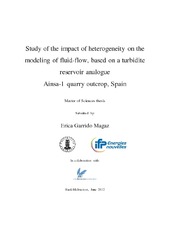Study of the impact of heterogeneity on the modeling of fluid-flow, based on a turbidite reservoir analogue Ainsa-1 quarry outcrop, Spain
Master thesis

View/
Date
2012-06-01Metadata
Show full item recordCollections
- Department of Earth Science [1050]
Abstract
Geological heterogeneity includes variations in porosity, lithology, mechanical properties, structure, etc. (Eaton, 2006) and in the case of sedimentary bodies, facies distribution acts as a constraint of them. It is proven that heterogeneity plays an important role on the control of reservoir production with regard to the fluid flow patterns. The objective of this master's thesis was to study the possible impact of reservoir heterogeneities on the flow paths applying an analogue outcrop of deep marine depositional environment, (Ainsa-1 quarry outcrop, northeast Spain). For that purpose it was created (1) a structural model with data loading, cell network and surface boundaries modeling, followed by a (2) facies distribution. The resulting reservoir model was checked by (3) numerical simulations of fluid flows, applying a petrophysical property model (permeability and porosity) using underdevelopment software called OpenFlow Suite 2012. For testing the influence of large scale heterogeneities we run two-phases fluid flow simulations using a quarter five-spots injection production, which were defined for being affected mainly by permeability heterogeneities without confounding effects. Thanks to this, they give an intuitive visualization of flow patterns, which can be probably similar to the flow paths in oil-recovery processes.